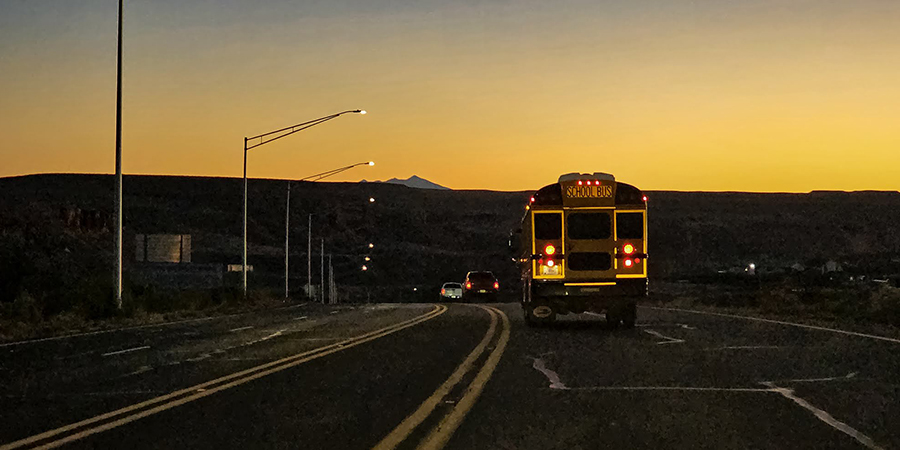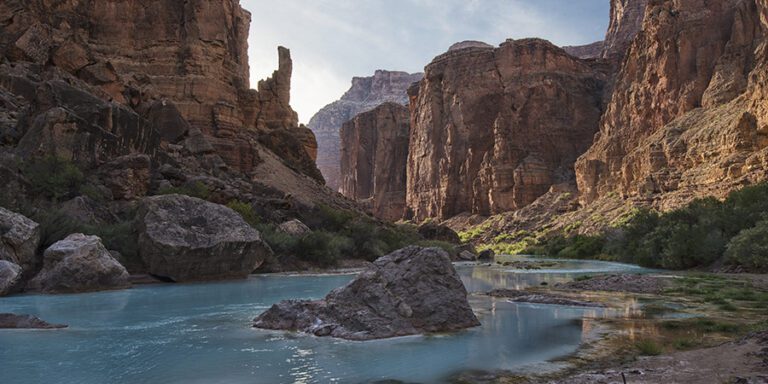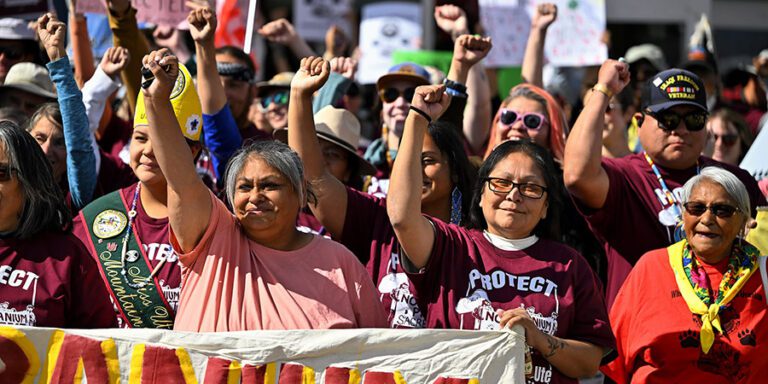
Four of the five most dangerous sections of the haul route are on the Navajo Nation.
A recent analysis of fatal vehicle accidents along the haul route uranium trucks travel between Canyon Mine (renamed Pinyon Plain Mine), a uranium mine near the Grand Canyon, and the White Mesa uranium mill in southeastern Utah shows an elevated risk along long stretches of the more than 300-mile route, especially on the Navajo Nation.
The most risky segments of the route are between 240% and 700% more dangerous than an average stretch of road in the United States in terms of vehicle accident fatalities per mile driven.
That means that any vehicles traveling in these sections face an elevated risk of fatal accidents. Energy Fuels Resources, which owns the controversial Pinyon Plain Mine, has said it intends to send six to eight large trucks loaded with uranium ore from the Grand Canyon area mine to its Utah mill every day.
Fatal accidents common along uranium haul route
Many communities along the haul route, which passes through towns in Arizona, the Hopi Reservation, the Navajo Nation, Utah, and the Ute Mountain Ute Reservation, oppose uranium hauling, fearing contamination and the risk of accidents on notoriously twisty, mostly two-lane roads. Hazards along the haul route range from flash floods to sink holes to icy road conditions, poor visibility, narrow canyons and steep dropoffs along cliff-edges, as well as wandering horses, cows, sheep, and wild animals.
Response times for emergency services along rural and remote sections of the route are also notoriously long. That means that, whether it’s an ambulance or a crew sent to clean up spilled radioactive uranium ore, first responders may need hours to reach the scene of an accident.
But how risky are the roads the uranium haul trucks travel, statistically? According to analysis by the Grand Canyon Trust’s Geographic Information Systems (GIS) team, the perception that the haul route is hazardous is well founded.
“We looked at fatal accident data collected by the National Highway Traffic Safety Administration’s Fatality Analysis Reporting System, covering nine years, from 2014 to 2022,” explained Grand Canyon Trust Senior GIS Analyst Josh O’Brien. “Then we crosswalked that data with average daily traffic counts collected by the Arizona and Utah state departments of transportation.”
Basically, the analysis looked at how many accidents you would expect along the haul route, statistically, compared to how many there actually were.
“Across the nation, the fatal accident rate for passenger vehicles was about 1.2 per 100 million miles traveled in 2022,” O’Brien noted. “Along some segments of the haul route, actual fatal accident rates were 2.4 to 7 times that.”
Most dangerous sections near Doney Park, Tuba City, Kayenta, and Dennehotso, conservative analysis shows

Statistically, the most dangerous sections of the Pinyon Plain Mine uranium truck haul route have been:
- East of the Mexican Water Trading Post, on Highway 160, near the Highway 191 junction
- In Doney Park, along Highway 89, east of Flagstaff
- East of Tuba City along Highway 160
- East of Dennehotso along Highway 160
- In the area around Tsegi Canyon along Highway 160, west of Kayenta
Four of the five most dangerous sections of the route are on the Navajo Nation.
See a photo gallery of the haul route, with photos and videos available for media and educational use
The analysis is conservative, in that it only looks at fatal accidents, not at all accident data. Of course, a uranium haul truck accident doesn’t have to be fatal to cause an environmental hazard. There were 113 fatal accidents along the haul route between 2014 and 2022, but anyone who regularly drives this route knows there are far more non-fatal accidents along these roadways. There were 1.05 billion total vehicle miles traveled along the haul route in 2022.
In 1987, two separate accidents involving haul trucks resulted in uranium ore spilling across highways on the Navajo Nation and in 1997, a uranium haul truck jackknifed in Colorado Springs, spreading ore across Interstate 25 and closing the highway.
“We would have liked to look at accident data along the haul route, not only fatal accidents, but that data just isn’t publicly available at a national level.” O’Brien said. “There are tons of records of vehicle accidents, police reports, things like that, but there’s no single dataset you can download of vehicle accidents across the country that contains their specific point locations.”
Even within the fatal accident data, O’Brien was conservative. He removed fatal accidents along highway on and off ramps from the analysis, since uranium haul trucks should not frequently be using these ramps. O’Brien also excluded fatal accidents in lanes traveling the opposite direction trucks will travel to the uranium mill when there was a significant physical space between the opposing lanes and it was unlikely that an accident would impact loaded vehicles traveling toward the mill.
“The statistical analysis is very clear,” O’Brien said. “Segments of the haul route are dangerous compared to the average for roads in the United States.”
With trucking paused, protests of uranium mine and mill continue

Trucking is currently paused while discussions between the Navajo Nation and Energy Fuels continue. Arizona’s attorney general continues to call for a new environmental review of the Pinyon Plain Mine, and advocates from the Havasupai Tribe, the Navajo Nation, and their supporters continue to call for the mine to close. Meanwhile, at the opposite end of the haul route, the White Mesa Ute community is organizing a spiritual walk to protest the White Mesa uranium mill, where the uranium ore is sent for processing. The grassroots group White Mesa Concerned Community invites supporters to join them in White Mesa on October 12, 2024.





